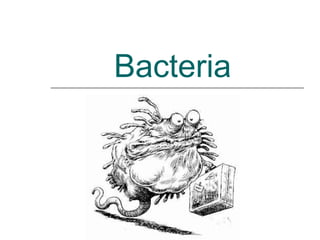
Bacteria 1
- 1. Bacteria
- 2. Quick Quiz True or False 1. 600 different kinds of bacteria live on your skin. True 2. Saliva contains 30 different kinds of bacteria. False; 6 3. Most bacteria multiply using the process of binary fission. True 4. You can see, taste, and smell bacteria. False; cannot see with naked eye 5. Leaving foods at room temperature will slow bacterial growth. False; Place in cold environments 6. There are more microbes on your body than there are humans on the entire planet. True.
- 3. True / False con’t 7. Bacteria help our bodies with digestion and produce True: E. coli makes vitamin K and B12 8. Bacteria are used to make chocolate. True; it helps digest the hard outer covering of the bean 9. Only 50% of all bacteria are helpful. False; 99% 10. The four shapes of bacteria are circular, square, rod, and spiral. False; No square
- 4. Prokaryotes vs. Eukaryotes Prokaryotes Eukaryotes No true Nucleus Membrane bound No membrane nucleus bound organelles Membrane bound Small organelles Simple Larger Evolved 3.5 bya Complex Evolved 1.5 bya
- 5. Bacteria Can be found almost everywhere on Earth. Earliest known fossils 3.5 bya Oldest group of organisms All bacteria are prokaryotes 2 main groups (kingdoms) Eubacteria Archaebacteria
- 6. EUBACTERIA / TRUE BACTERIA Most common today Cause disease & decay Cell wall protects and determines shape. Contains peptidoglycan (carbohydrate) Example: E. coli= live in intestines of humans
- 7. Archaebacteria “ancient bacteria” Live in extreme environments Direct ancestors of eukaryotes Examples: Methanogens= oxygen free environments thick mud and digestive tracks. Halophites= Salty environments Utah’s Great Salt Lake
- 8. Prokaryotes are Identified By their… 1. Shape 2. Chemical Nature 3. The way they move 4. The way they obtain energy.
- 9. Shapes of Bacteria Spherical (round / cocci) Streptococcus aureus Spiral (sprilla) Trepnema pallidum (syphilis) Rod-Shaped (bacillus) Escherichia coli
- 12. Cell Walls of Bacteria Gram staining helps distinguish between the 2 different types of bacteria. Gram + Thicker peptidoglycan walls Keeps dark stain Appears purple Gram – Thinner cell wall Appears pink
- 13. Gram Staining- Use to diagnose & treat disease Gram + Gram – Harmless Harmful Important Unaffected by in food and many dairy antibiotics. Can’t penetrate industries cell wall Turns purple Turns pink Ex) Ex) E. coli Streptococcus pneumonia
- 14. Movement 1) Flagella- whip like structures 2) Lash, snake, or Flagella Position spiral 3) Glide along slime
- 15. Obtaining Energy Heterotrophs- Getenergy by consuming organic molecules made by other organisms. Autotrophs- Make their own food from inorganic molecules.
- 16. Autotrophs Photoautotrophs Use sunlight to convert carbon dioxide & water to carbon compounds and oxygen. Ex: Cyanobacteria Chemoautrotrophs Use energy from chemical reactions to make organic carbon molecules Live in darkness; ocean bottoms.
- 17. Releasing Energy Obligate aerobes- require oxygen TB Mycobacteruim tuberculosis Obligate anaerobes- NO oxygen Clostridium botulinum (canned food) Facultative anaerobes- do not require oxygen but are not killed by it. E. coli (large intestines and canned food)
- 18. Growth & Reproduction Some bacteria can divide in ~20 min 3 ways bacteria divide 1) binary fission 2) Conjugation 3) Spore formation
- 19. Bacteria Reproduction Binary fission Asexual – clones Splitting in ½ 1st growth 2nd DNA is copied 3rd splits into 2 cells
- 20. Conjugation Sexual reproduction Hollow bridge forms between 2 bacteria cells Exchange of DNA Result: increase in genetic variation
- 21. Spore Formation Formed in unfavorable conditions Can keep for months or years Produces a thick internal wall that encloses the DNA & cytoplasm Dangerous
- 22. Limiting Factors in Bacteria Reproduction (Growth) Nutrients temp (freeze/ pasteurization) Moisture pH Time Sanitizing
- 23. Importance of Bacteria 1. Producers 2. Decomposers 3. Human uses
- 24. 1) Producers / Nitrogen Fixers Plants & animals depend on bacteria for nitrogen Need N2 to make amino acids. N2 makes up ~ 80% of Earth’s atm Plants take N2 convert it to NH3 (ammonia) this process is known as nitrogen fixation is done by bacteria.
- 25. 2) Decomposers Bacteria recycle nutrients Trees die -> Bacteria break down -> Nutrients are returned to the soil -> Process repeats
- 26. 3) Human Uses Food- cheese, yogurt Beverages- wine, milk Industry- digest petroleum, clean up oil spills Medical uses- synthesize drugs E. coli- makes vitamins the body cannot make Etc.